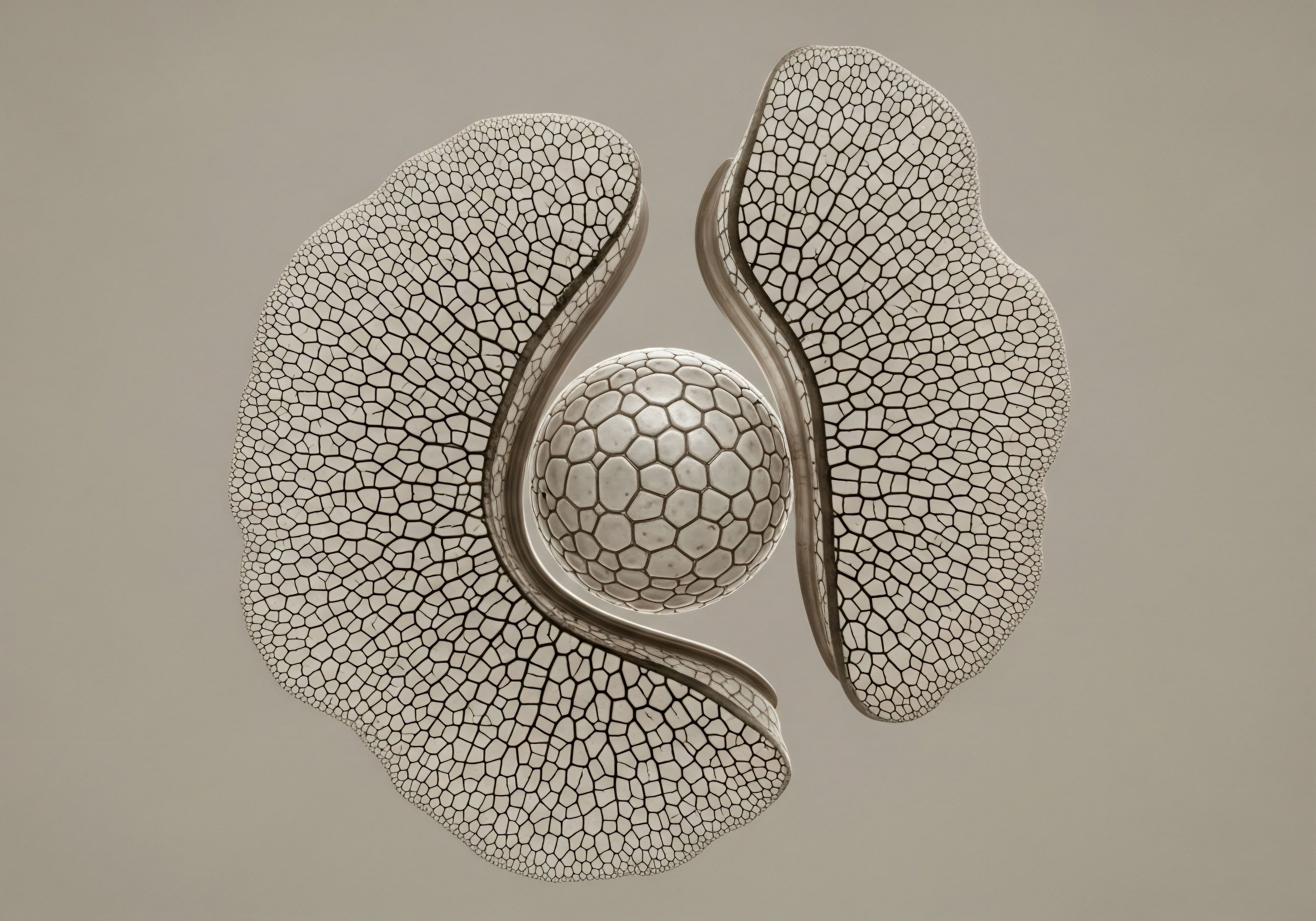

Fundamentals
You feel it as a subtle shift in your body’s internal weather. The energy that once came easily now feels distant. The reflection in the mirror shows a changing composition, a softness replacing what was once firm. This experience, this sense of a system running inefficiently, is a valid and deeply personal starting point for understanding your own biology.
When a diagnosis of prediabetes enters the conversation, it adds a layer of clinical urgency to what you have already been feeling. It is the body’s way of signaling that its intricate communication network, the one responsible for managing energy, is becoming strained.
Prediabetes represents a specific type of communication breakdown. Your cells, particularly in your muscles and liver, are becoming less responsive to the hormone insulin. Insulin’s job is to act as a key, unlocking cells to allow glucose, the body’s primary fuel, to enter and be used for energy.
In a state of prediabetes, it is as though the locks on your cells are becoming rusty. The pancreas, which produces insulin, must work harder, shouting its message louder to get the same effect. This sustained effort can lead to elevated blood sugar levels, the clinical hallmark of this condition.

The Two Primary Levers of Metabolic Control
When facing this challenge, it is helpful to visualize two distinct yet related levers of control you can access. The first lever is foundational and systemic. It involves lifestyle interventions, specifically targeted nutrition and consistent physical activity. Think of this as recalibrating the entire operating system of your body.
It directly addresses the cellular environment, cleans the communication lines, and makes the cell locks more receptive to insulin’s key. This approach works to restore the body’s innate metabolic intelligence from the ground up.
The second lever is more specific, targeting a particular communication pathway within the body. This is where hormonal optimization, such as testosterone therapy, comes into view. For men who have both prediabetes and clinically diagnosed low testosterone (hypogonadism), this second lever becomes relevant.
Testosterone is a powerful signaling molecule that influences muscle mass, fat distribution, and energy utilization. Restoring it to a healthy physiological range can be understood as tuning a critical instrument in the body’s endocrine orchestra. This action supports the work of the first lever, creating a more favorable internal environment for metabolic health to improve.
The journey to metabolic wellness begins with recognizing that lifestyle changes are the engine of systemic recalibration, while hormonal support can fine-tune specific biological pathways.
The conversation about managing prediabetes thus expands. It encompasses the universal, foundational work of lifestyle modification. For some individuals, it also includes a targeted, physiological adjustment through hormone therapy. The primary objective remains the same in both cases ∞ to re-establish clear, efficient communication within your body’s complex systems, allowing you to reclaim vitality and function.
Understanding how these two approaches function, both independently and together, is the first step toward building a precise and personalized protocol for your health.


Intermediate
Advancing from the foundational understanding of prediabetes, we arrive at the clinical application of specific protocols. This involves a detailed examination of the mechanisms through which both lifestyle interventions and testosterone therapy exert their effects. The goal is to move from the ‘what’ to the ‘how,’ appreciating the distinct biological processes each approach initiates. This level of understanding is where you begin to see your body as a system of interconnected pathways, each amenable to precise inputs.

Lifestyle Interventions as Metabolic Reprogramming
Structured lifestyle changes are the cornerstone of managing prediabetes because they directly target the root cause of the condition ∞ insulin resistance. These interventions are not merely suggestions to “eat better and move more”; they are specific strategies designed to reprogram metabolic function at a cellular level.

The Mechanics of Targeted Nutrition
A therapeutic dietary approach for prediabetes centers on managing the glucose and insulin load on the body. This is achieved by prioritizing foods that promote stable blood sugar. Complex carbohydrates, such as those found in vegetables, legumes, and whole grains, are digested slowly, preventing the sharp spikes in blood glucose that demand a surge of insulin.
Fiber, in particular, slows gastric emptying and improves the gut microbiome, which has a secondary beneficial effect on systemic inflammation and insulin sensitivity. Protein intake is also crucial, as it promotes satiety, helps preserve lean muscle mass during weight loss, and has a minimal impact on blood sugar levels.

Exercise as a Potent Insulin Sensitizer
Physical activity is a powerful tool for improving glycemic control. Its effects are both immediate and long-lasting. During exercise, muscles can take up glucose from the bloodstream without requiring insulin, a process mediated by a protein called GLUT4. Regular physical activity encourages the body to produce more of these GLUT4 transporters and makes them more efficient at moving to the cell surface. This directly reduces the amount of sugar in the blood and lessens the burden on the pancreas.
- Resistance Training ∞ Building more muscle through weightlifting or bodyweight exercises creates larger storage depots for glucose. Each pound of muscle is metabolically active tissue that naturally improves your body’s capacity to manage blood sugar.
- Aerobic Exercise ∞ Activities like brisk walking, cycling, or running improve cardiovascular health and enhance the efficiency of mitochondria, the energy factories within your cells. This improves overall energy utilization and fat metabolism.

Testosterone Therapy as an Adjunctive Protocol
For men with a confirmed diagnosis of hypogonadism, testosterone replacement therapy (TRT) introduces a powerful variable into the metabolic equation. The protocol is designed to restore hormonal balance, and in doing so, it can create secondary benefits that support the goals of a prediabetes management plan. The standard protocol often involves a coordinated use of several medications to ensure a balanced physiological response.

A Systems Approach to Hormonal Optimization
A typical TRT protocol for men is more complex than simply administering testosterone. It is a system designed to mimic the body’s natural endocrine function as closely as possible.
The core of the therapy is weekly intramuscular injections of Testosterone Cypionate. This provides a steady, reliable source of the primary male androgen. To prevent the testes from shutting down their own production, a common side effect of external testosterone administration, Gonadorelin is often included.
Gonadorelin is a peptide that stimulates the pituitary gland to release Luteinizing Hormone (LH) and Follicle-Stimulating Hormone (FSH), the signals that tell the testes to produce testosterone and maintain fertility. Finally, an aromatase inhibitor like Anastrozole is frequently used. Testosterone can be converted into estrogen in the body through a process called aromatization. Anastrozole blocks this conversion, which helps manage potential side effects and maintains a healthy testosterone-to-estrogen ratio.
While lifestyle changes directly improve cellular insulin sensitivity, testosterone therapy primarily works by optimizing body composition, which creates a more metabolically favorable internal environment.

How Does Restored Testosterone Influence the Body?
Testosterone’s metabolic influence is primarily driven by its effect on body composition. It promotes myogenesis, the process of creating new muscle fibers, and influences adipogenesis, the development of fat cells. Specifically, testosterone appears to encourage pluripotent stem cells to differentiate into the muscle lineage rather than the fat lineage.
This results in an increase in lean body mass and a decrease in fat mass, particularly visceral fat, the metabolically active fat stored around the organs that is a major contributor to insulin resistance. This shift in the body’s composition is inherently beneficial for metabolic health.
| Intervention | Primary Biological Target | Key Mechanism of Action | Primary Metabolic Outcome |
|---|---|---|---|
| Lifestyle (Diet & Exercise) | Muscle and Liver Cells | Increases GLUT4 translocation; improves cellular insulin receptor sensitivity. | Direct reduction in blood glucose and improved insulin efficiency. |
| Testosterone Therapy | Endocrine System (HPG Axis) | Restores physiological testosterone levels; shifts stem cell differentiation toward muscle. | Improved body composition (increased lean mass, decreased fat mass). |
Understanding these distinct mechanisms is vital. Lifestyle interventions are the direct, first-line treatment for the core problem of insulin resistance. Testosterone therapy, when clinically indicated for hypogonadism, acts as a powerful supporting intervention by fundamentally altering the body’s composition in a way that makes the work of lifestyle changes more effective.


Academic
A sophisticated analysis of testosterone therapy’s role in prediabetes requires moving beyond its established effects on body composition to critically evaluate its direct impact on glycemic control. This involves a deep exploration of the clinical evidence, particularly the tension between promising mechanistic data and the definitive outcomes of large-scale randomized controlled trials (RCTs).
The central question from a clinical science perspective is why the favorable changes in muscle and fat mass induced by testosterone do not consistently translate into the prevention of type 2 diabetes.

Reconciling Observational Data with Randomized Controlled Trials
For years, the scientific narrative was largely shaped by observational studies. These studies consistently showed an inverse correlation between testosterone levels and the incidence of type 2 diabetes. Furthermore, registry studies, which follow groups of men undergoing treatment in real-world settings, suggested that long-term testosterone therapy could dramatically reduce the progression from prediabetes to diabetes.
One such study reported that over 8 years, no men with prediabetes treated with testosterone progressed to type 2 diabetes, compared to over 40% in an untreated control group.
This evidence, while compelling, is subject to inherent limitations. Observational studies can identify associations, but they cannot definitively prove causation. Men who seek out and adhere to testosterone therapy may also be more proactive about their health in other ways, introducing a significant confounding variable. The gold standard for establishing therapeutic efficacy is the randomized, double-blind, placebo-controlled trial. This design minimizes bias and allows for a clear assessment of the intervention’s true effect.

A Critical Analysis of the TRAVERSE Trial
The Testosterone Replacement Therapy for Assessment of Long-Term Vascular Events and Efficacy Response in Hypogonadal Men (TRAVERSE) trial provides the highest level of evidence to date on this topic. A major substudy of this large trial specifically investigated the effect of testosterone therapy on glycemic control in middle-aged and older men with hypogonadism. The study included 1,175 men with prediabetes and 3,880 men with existing diabetes. Participants were randomized to receive either a 1.62% testosterone gel or a placebo gel.
The primary endpoint for the prediabetic group was the risk of progression to type 2 diabetes. The results were unequivocal. The risk of progression did not differ significantly between the testosterone group and the placebo group at any measured time point up to 48 months.
For instance, at 24 months, 10.1% of the testosterone group had progressed to diabetes, compared to 14.6% of the placebo group, a difference that was not statistically significant when all time points were considered. This finding from a robust, large-scale RCT directly challenges the conclusions drawn from previous observational data.
The findings of the TRAVERSE trial demonstrate that while testosterone therapy may offer benefits for symptoms of hypogonadism, it is not an effective primary intervention for preventing the progression of prediabetes to diabetes.

What Are the True Metabolic Effects of Testosterone
The TRAVERSE trial’s outcome forces a more refined understanding of testosterone’s metabolic role. The evidence for its positive effects on body composition remains strong. Multiple RCTs, including TRAVERSE, confirm that testosterone therapy consistently increases lean body mass and decreases total fat mass.
At a cellular level, testosterone enhances the expression of key proteins in the insulin signaling cascade, such as insulin receptor substrate-1 (IRS-1) and glucose transporter type 4 (GLUT4), in adipose tissue. It promotes the commitment of stem cells to a muscle lineage and inhibits their differentiation into fat cells.
The critical insight from TRAVERSE is that these body composition changes, while metabolically favorable, are insufficient on their own to alter the clinical course of progressing from prediabetes to diabetes for the majority of men. This suggests that the pathophysiology of this progression is dominated by factors that are more powerfully influenced by other interventions.

Why Might Body Composition Changes Be Insufficient?
A systems-biology perspective offers a potential explanation. The progression to type 2 diabetes is a complex process involving pancreatic beta-cell dysfunction, hepatic insulin resistance, and peripheral insulin resistance in muscle. While testosterone’s effect on muscle mass is beneficial, the primary drivers of the disease state may be the direct glucotoxic and lipotoxic effects on the pancreas and liver.
These are most effectively countered by the systemic metabolic recalibration that comes from dietary modification and regular physical activity. Lifestyle changes directly reduce the glucose and fatty acid load on the entire system, an effect that appears to be more clinically potent for preventing diabetes than the secondary benefits derived from hormonally-induced changes in body composition.
| Evidence Type | Study Design | Key Finding | Clinical Interpretation |
|---|---|---|---|
| Observational Registry Study | Follows a cohort of patients receiving a specific treatment over time, with a non-randomized control group. | Long-term TRT was associated with a near-zero rate of progression to T2D. | Suggests a strong potential benefit, but is highly susceptible to confounding variables (e.g. patient motivation). |
| Randomized Controlled Trial (TRAVERSE) | Random assignment of patients to either testosterone or placebo, with blinding of patients and investigators. | No statistically significant difference in progression to T2D between the testosterone and placebo groups. | Provides high-level evidence that TRT is not a primary preventative strategy for T2D in this population. |
Therefore, the clinical application of this knowledge is clear. The primary and foundational treatment for prediabetes is and remains intensive lifestyle modification. Testosterone therapy is an appropriate and effective treatment for the symptoms of diagnosed hypogonadism. While it confers benefits to body composition that are supportive of metabolic health, it should not be prescribed with the primary goal of preventing diabetes.

References
- Preston, M. A. et al. “Effect of Testosterone on Progression From Prediabetes to Diabetes in Men With Hypogonadism ∞ A Substudy of the TRAVERSE Randomized Clinical Trial.” JAMA Internal Medicine, vol. 184, no. 4, 2024, pp. 435-443.
- Grossmann, M. and M. J. Matsumoto. “A Perspective on the Effect of Testosterone on Glucose Metabolism ∞ A Tale of Two Tissues.” Diabetes Care, vol. 40, no. 7, 2017, pp. 821-823.
- Saad, F. et al. “Testosterone Therapy in Men With Hypogonadism Prevents Progression From Prediabetes to Type 2 Diabetes ∞ Eight-Year Data From a Registry Study.” Diabetes Care, vol. 42, no. 6, 2019, pp. 1104-1111.
- Pitteloud, N. et al. “Relationship between testosterone levels, insulin sensitivity, and mitochondrial function in men.” Diabetes Care, vol. 28, no. 7, 2005, pp. 1636-1642.
- Dandona, P. and S. Dhindsa. “Mechanisms underlying the metabolic actions of testosterone in humans ∞ A narrative review.” Diabetes, Obesity and Metabolism, vol. 23, no. 1, 2021, pp. 15-27.
- Grossmann, M. “Testosterone and glucose metabolism in men ∞ current concepts and controversies.” Journal of Endocrinology, vol. 220, no. 3, 2014, pp. R37-R55.
- Corona, G. et al. “Testosterone, cardiovascular disease and the metabolic syndrome.” Best Practice & Research Clinical Endocrinology & Metabolism, vol. 25, no. 2, 2011, pp. 337-353.

Reflection
You have now seen the blueprint of the body’s metabolic and endocrine systems, examining how they function and how they can be influenced. You have seen the robust, foundational power of lifestyle changes and the specific, targeted role of hormonal therapy. This knowledge is a map. It shows the territory, highlights the primary roads, and points out the secondary paths. The next step in any health journey involves looking inward, from the map to your own unique landscape.
The information presented here is the beginning of a conversation with yourself and with trusted clinical guides. It prompts a deeper inquiry. Which systems in your body are calling for attention? Is the foundation of your lifestyle solid, built with the materials of nourishing food and consistent movement?
Or does that structure need reinforcement first? Considering a targeted intervention like hormonal optimization is only possible once the foundation is secure. Your personal path to vitality is built by understanding these principles and then applying them with precision to your own biology, your own life, and your own goals.



